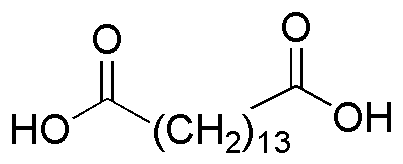Pentadecanedioic acid is widely utilized in research focused on:
- Biodegradable Polymers: This compound serves as a key building block for the synthesis of biodegradable polyesters, which are increasingly important in reducing plastic waste. Its long carbon chain enhances the mechanical properties of the resulting materials.
- Cosmetic Formulations: In the cosmetics industry, it is used as an emollient and thickening agent, providing a smooth texture and enhancing the moisturizing properties of creams and lotions.
- Food Industry: Pentadecanedioic acid can be utilized as a food additive, contributing to flavor enhancement and preservation. Its unique properties help in stabilizing emulsions in various food products.
- Pharmaceutical Applications: It is explored in drug formulation as a potential carrier for active pharmaceutical ingredients, improving solubility and bioavailability of certain medications.
- Surfactant Production: This compound is also used in the manufacture of surfactants, which are essential in detergents and cleaning products, providing effective cleaning while being environmentally friendly.
General Information
Properties
Safety and Regulations
Applications
Pentadecanedioic acid is widely utilized in research focused on:
- Biodegradable Polymers: This compound serves as a key building block for the synthesis of biodegradable polyesters, which are increasingly important in reducing plastic waste. Its long carbon chain enhances the mechanical properties of the resulting materials.
- Cosmetic Formulations: In the cosmetics industry, it is used as an emollient and thickening agent, providing a smooth texture and enhancing the moisturizing properties of creams and lotions.
- Food Industry: Pentadecanedioic acid can be utilized as a food additive, contributing to flavor enhancement and preservation. Its unique properties help in stabilizing emulsions in various food products.
- Pharmaceutical Applications: It is explored in drug formulation as a potential carrier for active pharmaceutical ingredients, improving solubility and bioavailability of certain medications.
- Surfactant Production: This compound is also used in the manufacture of surfactants, which are essential in detergents and cleaning products, providing effective cleaning while being environmentally friendly.
Documents
Safety Data Sheets (SDS)
The SDS provides comprehensive safety information on handling, storage, and disposal of the product.
Product Specification (PS)
The PS provides a comprehensive breakdown of the product’s properties, including chemical composition, physical state, purity, and storage requirements. It also details acceptable quality ranges and the product's intended applications.
Certificates of Analysis (COA)
Search for Certificates of Analysis (COA) by entering the products Lot Number. Lot and Batch Numbers can be found on a product’s label following the words ‘Lot’ or ‘Batch’.
*Catalog Number
*Lot Number
Certificates Of Origin (COO)
This COO confirms the country where the product was manufactured, and also details the materials and components used in it and whether it is derived from natural, synthetic, or other specific sources. This certificate may be required for customs, trade, and regulatory compliance.
*Catalog Number
*Lot Number
Safety Data Sheets (SDS)
The SDS provides comprehensive safety information on handling, storage, and disposal of the product.
DownloadProduct Specification (PS)
The PS provides a comprehensive breakdown of the product’s properties, including chemical composition, physical state, purity, and storage requirements. It also details acceptable quality ranges and the product's intended applications.
DownloadCertificates of Analysis (COA)
Search for Certificates of Analysis (COA) by entering the products Lot Number. Lot and Batch Numbers can be found on a product’s label following the words ‘Lot’ or ‘Batch’.
*Catalog Number
*Lot Number
Certificates Of Origin (COO)
This COO confirms the country where the product was manufactured, and also details the materials and components used in it and whether it is derived from natural, synthetic, or other specific sources. This certificate may be required for customs, trade, and regulatory compliance.

